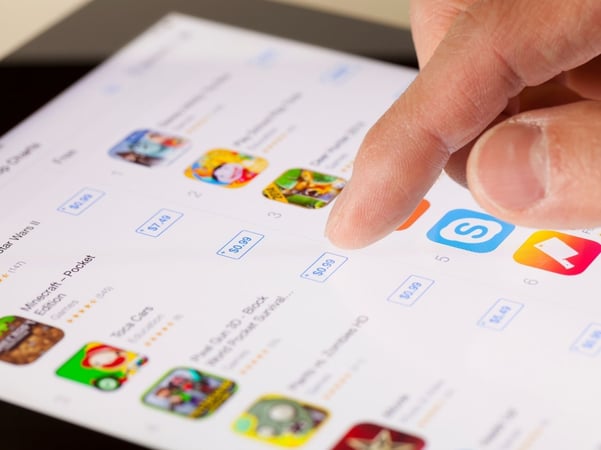App Marketing Strategies We Use at Each Stage of the Marketing Cycle
by Game Marketing Genie, on 15-Dec-2020 11:24:13
The iOS App Store and Google Play Store are both flooded with apps, making it hard for your app to get the results it deserves. That’s why you need to know the right strategies to help your game stand out in today’s hypercompetitive market. While focusing on app development and creating a game that functions properly is a critical factor for success, if players don't know your game exists, all your hard work is worthless.
Game app marketing covers every interaction from the moment players learn about your game until they become repeat users. The ultimate goal of video game marketing is to acquire players that will drive repeat engagement and become loyal advocates for your brand.
This guide examines the stages of an app marketing strategy and the metrics you should measure to generate long-term success.
Awareness
The awareness stage occurs before your app is launched. The purpose of this stage is product visibility and building brand awareness. Specifically, how will players discover your game?
Before beginning this stage, you need a clear understanding of your messaging and brand positioning. A brand resonates with users through its goals and values, not through product features. Defining your brand position gives your customers the chance to connect with your app on a deeper level.
Here are the strategies to follow at the awareness stage to make your marketing a success:
Understand your customers
One of the common pre-launch mistakes developers make is not conducting proper market research. Before starting your development work, study the market to identify the problems customers face that you can solve with your product. If your game doesn’t address any user pain-point, your chances of success are low.
Next, create user personas that map out your ideal customer. The persona should include everything from the user’s demographics, interests, background to mobile preference. Thoroughly outlining your audience with user personas will help you customize your game marketing to your user's needs and preferences.
Competitive analysis
Your game app will have competition, so it's crucial to identify who they are to ensure you don't repeat their mistakes. Prepare a list of your top competitors, stating their prize, app store rating, UX pros and cons, and app reviews. Understanding your competitors will help you know what to do to make your app stand out.
Promotional materials
You should prepare promotional materials that will help you market your game to the masses. Start by designing a landing page that describes your app and its features. You will also use the landing page to collect visitor emails so they can get notified when your game is released.
It's at this stage as well that you will roll your content marketing strategy. Start with a blog to drive traffic, conversions and to build awareness for your product. Promote your game on social media with targeted posts on the platforms that are popular with your target audience.

Acquisition
A user acquisition strategy is an integral part of your mobile app marketing strategy as it will help you increase your app's discoverability to attract more users. This stage comes after you have launched the app and its main aim is to help you achieve as many downloads as possible within the first week. The more rapidly your game is downloaded, the higher it will rank in app stores, so you need to find creative methods to make people aware of your game.
Here are some of the best game marketing strategies you can use to acquire users:
App store optimization
According to data from Apple, 65 percent of apps are discovered through app store searches making app store optimization an effective strategy to improve your app’s discoverability. App store optimization (ASO) is the process of optimizing your product page to rank higher on app stores like Google Play Store for Android and App Store for iOS. A higher rank makes your game app more visible to players, and the increased visibility will help you get more downloads.
We have explained in detail the tactics that will help you attain a higher ranking on app store searches in our blog, Game ASO: How to Make Your Video Game Stand out in App Stores.
Paid strategy
A paid marketing plan with ads on social media platforms like Facebook and LinkedIn are great for user acquisition. After all, these platforms aren’t just for marketing browser-based social media games! Social ads allow you to target your desired audience based on their demographics, interest, and more. Google search ads are also an excellent option to capture those who use search engines to discover appropriate apps.
You can measure your app acquisition strategy's effectiveness by tracking your app store page visits and how many people visited your landing page from your targeted ads.

Activation
Once users download your game, the next task is to win their usage. The activation step is concerned with making users feel your game's value to ensure they don't churn. Customers who don’t feel the benefit of your game during their first interaction will abandon it and move to other attractive games. To prevent this from happening, personalize the onboarding process to grab the user’s attention from the beginning.
Reduce the learning curve associated with your app to make the onboarding process easier and hook the players from the first session. Simplify the registration process by getting rid of complicated sign-up forms and instead ask for the bare essentials like an email address or Facebook log-in.
The number of registrations you get is one of the activation metrics you can track, but it doesn't capture how gamers interact with your title. To get a clear picture of your app's usage, you should track the following metrics:
- Session length: The amount of time users spend on your game. In this case, longer sessions mean greater activations.
- Screens per session: The different screens (pages) of the game a player launches in a single session. Again, more screens per session mean greater activation.
- One-day retention: How many players continue to use your game 24 hours after installing it. This metric is between the Activation and Retention stages, and it calculates the percentage of players who enjoyed their first session of your game enough to use it again.

Retention
Most developers put a lot of effort into acquiring users but lack the needed strategies to retain them long-term. Your app could have many registered users, but your game isn't yielding business if they aren't using it. Your next move should be to work with an game marketing agency that specializes in apps to develop a retention plan that will help you convert new players into lifelong users.
Here are the strategies that will help you increase user retention:
Push notifications
Push notifications are attention-grabbing communication vehicles that will help you share important information with your users. You can use them to inform the players about upcoming sales, new product features, special content access, and other offers.
Figure 1: Uses of push notifications. Source: Business of Apps
Users who have enabled push notification have a higher app engagement, which will help you retain them for a long time. A high retention rate will boost your app store ranking, which will give your app more visibility and help you attract more users.
Two-way communication
Your app should support user to user communication to build engagement. When players feel like they belong to a community, they will be motivated to return to the app, which will improve your retention rate.
Loyalty campaigns
Reward your customers with virtual currency, discounts or premium features for regularly using your app. Loyalty campaigns create a gamified experience that will encourage users to play your game.
The metrics you can use to measure retention include n-Day retention, which is the percentage of players using your game "n" days after installation, monthly active users (MAUs), and session frequency, which is the number of times your active customers launch your app in a given timeframe (usually one week). A higher session frequency indicates greater engagement and conversion.

Monetization
Monetization is the end goal of most app marketing campaigns, but it can be very challenging because of cheaper and even free alternatives. Your ability to monetize your app depends largely on how successfully you implement the above tiers, i.e. raising awareness, improving engagement, building loyalty, and earning customer love.
Your game revenue can take different forms depending on your business model. Apps with a freemium or subscription model generate revenues from direct transactions with users. Free games with an ad-based model don't have direct transactions with the customers, and they earn their income by increasing ad impressions through growing their app usage and loyalty.
Besides paid downloads and advertising, you can also use in-app purchases like virtual goods and exclusive content that enhance the app experience.
As a developer, you must actively monitor your game’s revenue to determine if you are on track to meet your goals.
Our blog, How to Measure the True Revenue Performance of Your Mobile Game, explains everything you need to know on this topic.
Beyond the total revenue your app makes, there are other meaningful ways to analyze your app's profitability, such as:
- Average revenue per user (ARPU): This is the total app revenue over a given time frame averaged over the monthly active users during that time.
- Customer lifetime value (LTV): A predictive figure of the amount a player will generate during the relationship with your game.
- Ad revenue: Revenue from ads displayed in your app.
- Subscriptions: Income generated from subscription fees.
- App purchases: Revenue from the purchases of your paid app.

Referral
This part of the game marketing framework is all about getting your loyal customers to recommend your game to their friends. A recent study by Nielsen found that friends' recommendations are the most credible form of product advertising, with 83 percent of consumers saying they trust recommendations more than other ads.
With an effective referral program, you will get more people to download your game and retain them long-term. Referral marketing is also a cheaper method for acquiring users who have a higher customer lifetime value, resulting in higher retention rates.
Making your app easy to share drives app referrals. Below is what you need to do to achieve this:
- One-click sharing: Players should be able to share your game in just one click. Incorporate built-in share buttons and email referral links to make this process effortless.
- Social/contact list integration: Ask for permission to connect your app with the user’s social network contacts or phonebook contact list. Once this is done, users can check their contact list from the app and mass share it.
- Incentivized sharing: Find a way to incentivize your customers to share your game. You can offer them premium content features or in-app currency in exchange for a share.
- Rating prompts: Design in-app messages that encourage your users to leave an app store rating for your game. Time the message pop-ups intelligently to boost user sentiment and the review quality.
Once your referral program is set, track the app store rating to assess your customer satisfaction. You can also use social media tools to track your app’s social buzz by checking how your game has been mentioned on social networks.

Mobile game marketing made easy
Mobile game marketing is your key to the quest for success! Take control of your new game and make its marketing matter with the help of our insider tips in Mobile Game Marketing: Your Complete Guide to Success.
With the number of games available to consumers increasing by the day, it's only with a meticulous marketing strategy that your game will stand out in today's competitive market. While this is a comprehensive guide, it is only a few of the strategies we’ve got up our sleeves here at Game Marketing Genie.
Contact us to find out how we can help you create an end-to-end app marketing strategy that is set to get the return you desire.
Avoid common game app marketing pitfalls and set yourself up for success in the competitive gaming industry. Check out our marketing strategy page for more information on how to market your game.


